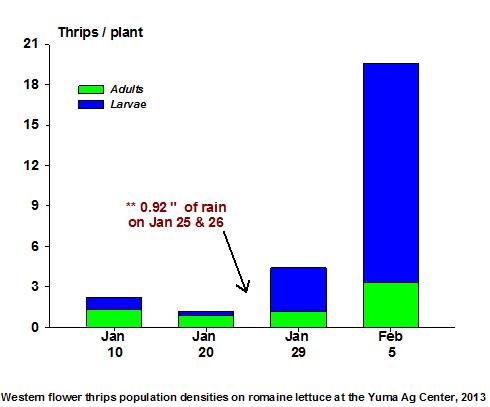Feb 6, 2013
Western Flower Thrips Populations Beginning to Build
Western flower thrips are now beginning to increase on produce crops throughout the area. They have slowly been increasing in the Yuma Valley, and should likely continue to increase as the days grow longer. With the heavy rain we experienced a week or so ago in the Yuma area (0.75-1.2"), one might anticipate reductions in numbers like we typically see in wet springs. Heavy rainfall can dislodge or even drown adult thrips on plants, and can suffocate larvae in the soil if it remains wet for prolonged periods. However, the recent rainfall did not appear to slow down thrips population development in lettuce at the Yuma Ag Center as we would have expected
(see graph below). Populations were relatively light prior to the rain, but immediately following the storm, samples showed a significant increase in larvae. About a week later (Feb 5) population density increased almost 5 -fold. Obviously, the rainfall was not sufficient enough to impact these populations in the field. Based on historical data, if temperatures remain moderate and rainfall is light we can expect thrips numbers to reach high levels by the end of the month. Another factor PCAs should be concerned with this time of the year is thrips
"bioconcentration" which occurs each year in late February and March as lettuce acreage declines. This could be especially important this season since there appears to be less lettuce present at this time of the year relative to years past. Each time a lettuce field is harvested and disked, adult thrips populations disperse from these areas into the next available lettuce field. This is generally coincident with our seasonally warm temperatures that are suitable for thrips development. As the number of lettuce acres becomes reduced near the end of the season, this creates a bottleneck effect that concentrates high numbers of thrips adults on the remaining fields under production. This can often make chemical control very difficult, particularly in March, as thrips adults may continually re-infest fields following spray applications. Furthermore, by mid-March when most of the lettuce production is finished, these populations can pose a threat to seedling cotton.
Note: the key to preventing thrips from significantly scarring leafy vegetable plants is to prevent immature populations from becoming established. For more information on the identification, biology, ecology and management of thrips on desert produce please visit these link:
Insect Management on Desert Produce Crops
To contact John Palumbo go to:
jpalumbo@ag.Arizona.edu
 To contact John Palumbo go to: jpalumbo@ag.Arizona.edu
To contact John Palumbo go to: jpalumbo@ag.Arizona.edu












